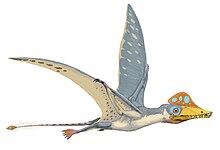Scaphognathus
| Scaphognathus | |
|---|---|

| |
| Cast of the holotype specimen | |
| Scientific classification | |
| Domain: | Eukaryota |
| Kingdom: | Animalia |
| Phylum: | Chordata |
| Order: | †Pterosauria |
| Family: | †Rhamphorhynchidae |
| Subfamily: | † Scaphognathinae
|
| Genus: | †Scaphognathus Wagner, 1861 |
| Type species | |
| †Pterodactylus crassirostris Goldfuss, 1831
| |
| Species | |
| |
| Synonyms | |
| |
Scaphognathus was a pterosaur that lived around Germany during the Late Jurassic. It had a wingspan of 0.9 m (3 ft).
Naming

The first known Scaphognathus specimen was described in 1831 by
In the early twentieth century, the "rhamphorhynchoid" nature of S. crassirostris was recognized after the discovery of the second specimen in Mühlheim, whose long tail was preserved. The second Scaphognathus specimen was more complete than its predecessor, but only half the size (twenty inch wingspan) and with partially ossified bones.[2] These characters indicate that the second specimen was a juvenile.[2]
Description

The Scaphognathus is known from three specimens, all of which originated in the Kimmeridgian-age[4] Solnhofen Limestone.[2] Physically it was very similar to Rhamphorhynchus, albeit with notable cranial differences.[2]
For one, Scaphognathus had a proportionately shorter skull (4.5 in) with a blunter tip and a larger antorbital fenestra.[2] Its teeth oriented vertically rather than horizontally. The traditional count of them held that eighteen teeth were in the upper jaws and ten in the lower.[2] S. Christopher Bennett, studying a new third specimen, SMNS 59395, in 2004 determined there were only sixteen teeth in the upper jaws, the higher previous number having been caused by incorrectly adding replacement teeth.[5]

Comparisons between the
Classification

The cladogram (family tree) of rhamphorhynchids below is the result of a large
| Breviquartossa
|
| |||||||||||||||||||||||||||||||||||||||||||||
See also
- List of pterosaur genera
- Timeline of pterosaur research
- Solnhofen limestone
References
- ^ Goldfuss G. A. (1830). "Pterodactylus crassirostris". Isis von Oken, Jena pp. 552–553
- ^ a b c d e f g "Scaphognathus." In: Cranfield, Ingrid (ed.). The Illustrated Directory of Dinosaurs and Other Prehistoric Creatures. London: Salamander Books, Ltd. Pp. 308–309.
- ^ Wagner, J.A. (1861). "Uebersicht über die fossilen Reptilien des lithographischen Schiefers in Bayern nach ihren Gattungen und Arten". Sitzungsberichte der königlich bayerischen Akademie der Wissenschaften zu München, 1861 Theil 1: 497–535.
- ISBN 0-520-24209-2.
- ^ Bennett, S. C. (2004). "New information on the pterosaur Scaphognathus crassirostris and the pterosaurian cervical series", Journal of Vertebrate Paleontology, 24(Supplement to #3):38A
- PMID 21493820.
- .
Literature
- Fantastic Facts About Dinosaurs (ISBN 0-7525-3166-2)
